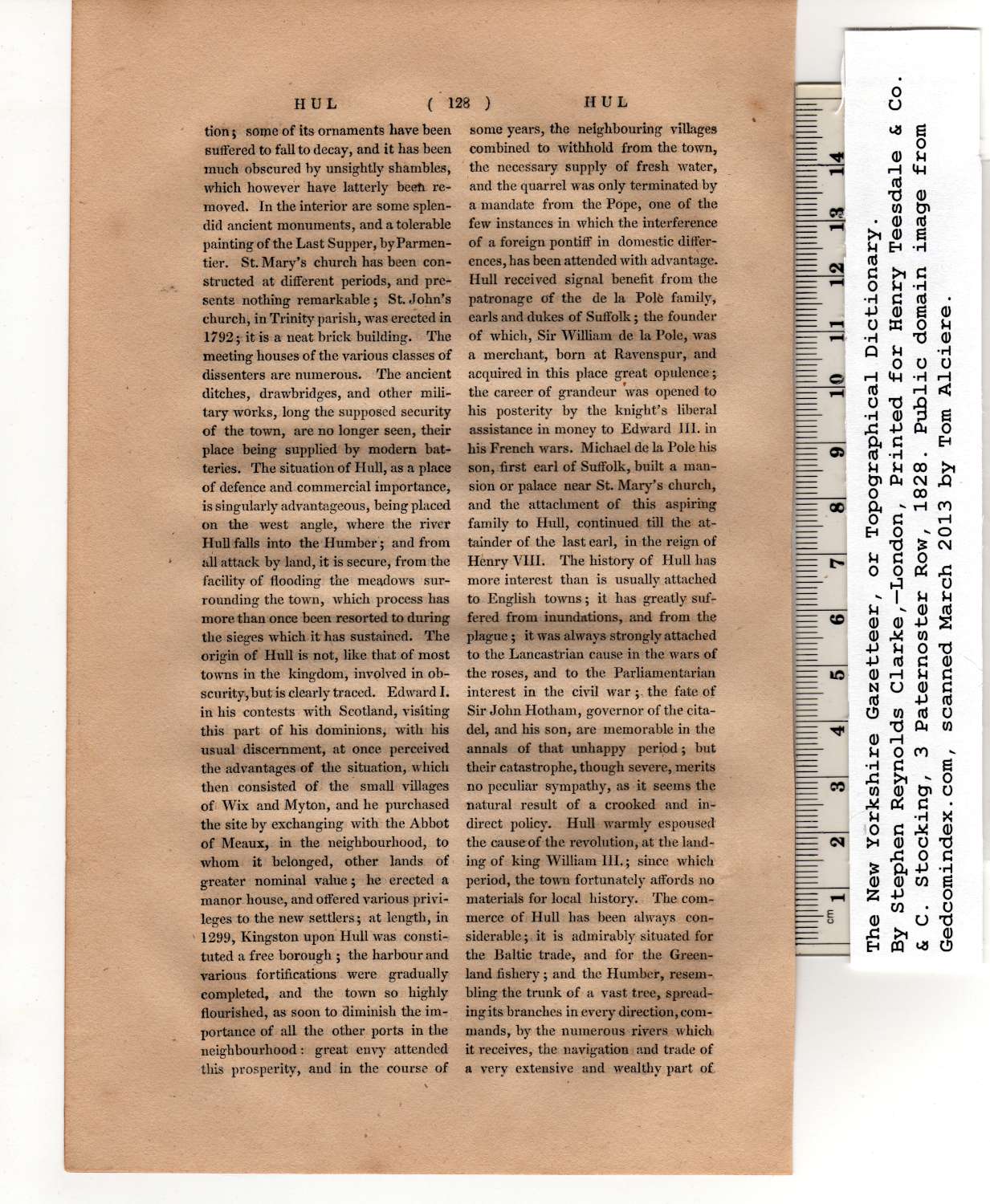|
tion 5 some of its ornaments have been
suffered to fall to decay, and it has been
much obscured by unsightly shambles,
which however have latterly beeti re-
moved. In the interior are some splen-
did ancient monuments, and a tolerable
painting of the Last Supper, byParmen-
tier. St. Mary’s church has been con-
structed at different periods, and pre-
sents nothing remarkable; St. John’s
church, in Trinity parish, was erected in
1792; it is a neat brick building. The
meeting houses of the various classes of
dissenters are numerous. The ancient
ditches, drawbridges, and other mili-
tary works, long the supposed security
of the town, are no longer seen, their
place being supplied by modern bat-
teries. The situation of Hull, as a place
of defence and commercial importance,
is singularly advantageous, being placed
on the west angle, where the river
Hull falls into the Humber; and from
all attack by land, it is secure, from the
facility of flooding the meadows sur-
rounding the town, which process has
more than once been resorted to during
the sieges which it has sustained. The
origin of Hull is not, like that of most
towns in the kingdom, involved in ob-
scurity, but is clearly traced. Edward I.
in his contests with Scotland, visiting
this part of his dominions, with his
usual discernment, at once perceived
the advantages of the situation, which
then consisted of the small villages
of Wix and Myton, and he purchased
the site by exchanging with the Abbot
of Meaux, in the neighbourhood, to
whom it belonged, other lands of
greater nominal value; he erected a
manor house, and offered various privi-
leges to the new settlers; at length, in
1299, Kingston upon Hull was consti-
tuted a free borough ; the harbour and
various fortifications were gradually
completed, and the town so highly
flourished, as soon to diminish the im-
portance of all the other ports in the
neighbourhood: great envy attended
this prosperity, and in the course of
some years, the neighbouring villages
combined to withhold from the town,
the necessary supply of fresh water,
and the quarrel was only terminated by
a mandate from the Pope, one of the
few instances in which the interference
of a foreign pontiff in domestic differ-
ences, has been attended with advantage.
Hull received signal benefit from the
patronage of the de la Pole family,
earls and dukes of Suffolk; the founder
of which, Sir William de la Pole, was
a merchant, born at Ravenspur, and
acquired in this place great opulence;
the career of grandeur was opened to
his posterity by the knight’s liberal
assistance in money to Edward III. in
his French wars. Michael de la Pole his
son, first earl of Suffolk, built a man-
sion or palace near St. Mary’s church,
and the attachment of this aspiring
family to Hull, continued till the at-
tainder of the last earl, in the reign of
Henry VIII. The history of Hull has
more interest than is usually attached
to English towns; it has greatly suf-
fered from inundations, and from the
plague; it was always strongly attached
to the Lancastrian cause in the wars of
the roses, and to the Parliamentarian
interest in the civil war; the fate of
Sir John Hotham, governor of the cita-
del, and his son, are memorable in the
annals of that unhappy period; but
their catastrophe, though severe, merits
no peculiar sympathy, as it seems the
natural result of a crooked and in-
direct policy. Hull warmly espoused
the causeof the revolution, at the land-
ing of king William III.; since which
period, the town fortunately affords no
materials for local history. The com-
merce of Hull has been always con-
siderable ; it is admirably situated for
the Baltic trade, and for the Green-
land fishery; and the Humber, resem-
bling the trunk of a vast tree, spread-
ing its branches in every direction, com-
mands, by the numerous rivers which
it receives, the navigation and trade of
a very extensive and wealthy part of |
